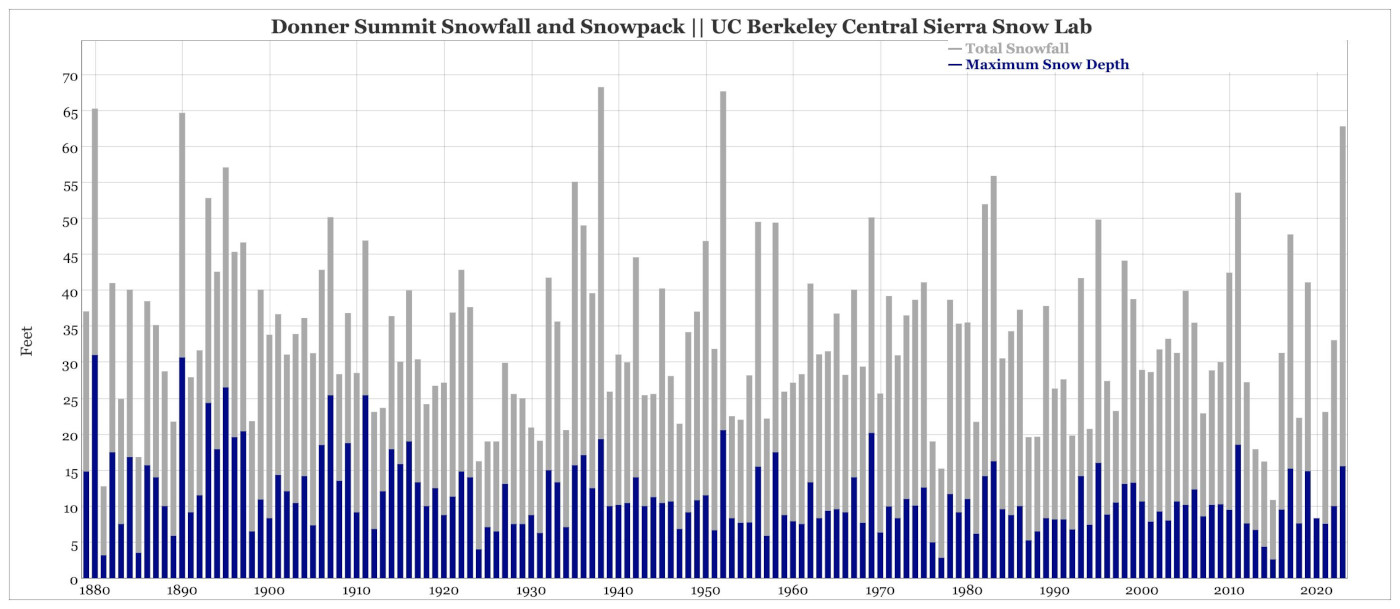|
"Some people are weatherwise, but most people are otherwise."
— Benjamin Franklin
Sierra Nevada Snowfall Records as of December 2013
Echo Summit, California
Second heaviest U.S. 24-hour snowfall record: 67 inches (5.6 feet) January 4-5, 1982 1,2
Mount Shasta Ski Bowl, California
U. S. single storm snowfall record: 189 inches (15.75 feet) February 13 – 19, 1959 3
Tamarack, California
U.S. snowfall record for one month: 390 inches (32.5 feet) January 1911
Tamarack, California
U.S. seasonal snow depth record: 454 inches (37.8 feet) March 1911
Donner Summit, California
U.S. snowiest April: 298 inches (24.8 feet) April 1880 4
Tamarack, California
Sierra Nevada record snowfall during one season:
884 inches (73.7 feet) 1906-07 5
Top Three Snowstorms USFS Central Sierra Snow Laboratory (CSSL) 6
- March 27 to April 8, 1982 —
15.5 feet
- January 20 to 31, 1969 —
13.7 feet
- January 10 to 17, 1952 —
12.8 feet
(Twelve other snowfall events at the CSSL have each dumped nearly ten feet, with a mean storm-duration of 11.4
days. Snowstorm totals greater than six feet are not uncommon.)
Top Three 24-hour Snowstorms at the Central Sierra Snow Laboratory
- February 3, 1989 — 52 inches
- October 21, 1967 — 46.5 inches
- February 19, 1980 — 46.1 inches
Top Five Maximum Snow Depths at the Central Sierra Snow Laboratory 7
- 1952 — 311 inches (26.0 feet)
- 1969 — 242 inches (20.2 feet)
- 1971 — 240 inches (20 feet)
- 1958 — 210 inches (17.5 feet)
- 2011 — 207 inches (17.2 feet)
1 The North American record is held by Silver Lake, Colorado, which received 76 inches (6.3 feet) in 24 hours on April 14-15, 1921.
2 Montague, New York, located just east of Lake Ontario, reported 77 inches in 24 hours on January 11-12, 1997. The measurement was disallowed, however, after the National Climate Extremes Committee determined that the total of 77 inches was achieved by adding six measurements together, two more than the maximum allowed during any 24-hour period.
3 A comparable snow event occurred near Donner Pass in mid-February 1999, when a powerful winter storm dumped 168 inches (14 feet) at Sugar Bowl Ski Resort from February 6 to 9.
4 Measured by Southern Pacific Railroad at Summit Station elevation 7,017 feet.
5 U.S. seasonal snowfall record currently held by the Mount Baker ski area where 1,140 inches (95 feet) were measured during the 1998-99 winter season. Measurement location was the Heather Meadows day lodge at 4,300 feet in elevation.
6 The Central Sierra Snow Laboratory is situated at 6,950 feet in elevation and located just west of the Sierra Crest near Donner Summit in the Yuba River basin. Much of California receives less than 24 inches of precipitation annually, in fact, one third of the state averages less than 6 inches of rain a year. In contrast, Donner Summit's annual average precipitation is nearly 54 inches with most of the precipitation falling as snow. Precipitation is rain and snow melt combined. The snowfall season generally begins in early November and usually lasts through May. Historically, November through March comprise 76% of the annual precipitation, with January and February the two wettest months, comprising 34% of the total. Donner Pass is typically quite dry from June through September with only 5% of the annual precipitation falling in this four-month period. October 1 is historically the date of minimum runoff and reservoir levels in California and also the beginning of the rainy season. The Sierra Nevada water year runs from October 1 to September 30.
7 Snowfall and snowpack data from the CSSL archive dating from 1878 to1945, and from 1952 to1957, were measured and supplied by the Southern Pacific Transportation Company. Snowpack and snowfall measurements were taken at Summit Station from 1878 through 1927, and at Norden from 1927 on. From 1879 to 1897, and 1901, the maximum snowpack depth was estimated. Current CSSL methodology mandates that new snow is measured twice a day, at 0800 and 1600 Pacific Standard Time. The depth of the new snow is probed with a rule at the four corners of a snow board. [The snow board is piece of plastic-covered plywood, .25m2 in area.] The four depths are recorded and averaged, the board is then cleaned off and replaced on the snowpack surface.
[Ref: Randall S. Osterhuber, Climatic Summary of Donner Summit, California, Central Sierra Snow Laboratory,
October 1993]
|

